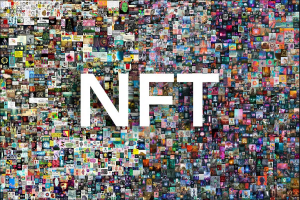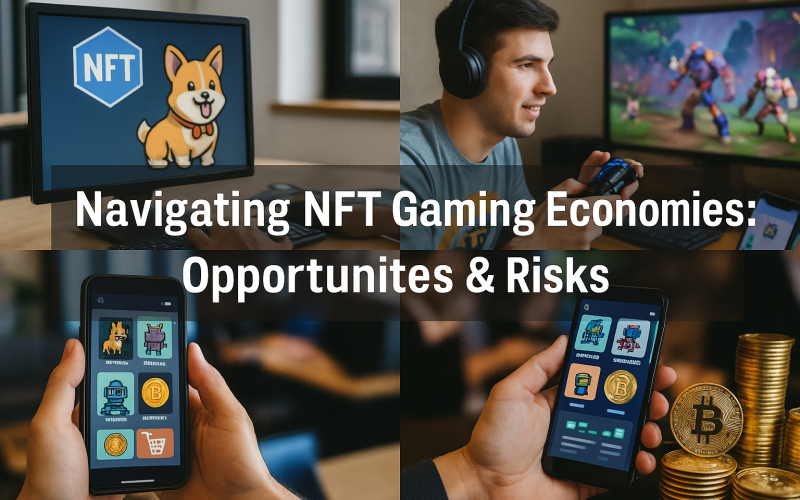Introduction
In 2021 “play-to-earn” turned gamers into overnight market traders, but wild price swings soon cooled the hype. Four years later the landscape looks sharper, safer, and far more complex. Large studios launch blockchain titles beside indie devs, regulators write clearer tax rules, and players ask tougher questions about fairness. At the same time, billions of dollars still move through virtual swords, racing cars, land plots, and team badges—all recorded as non-fungible tokens, or NFTs.
Understanding these new economies is no longer optional for anyone who loves games, collects digital goods, or hunts fresh investment angles. Where do profits really come from? How do token prices match in-game fun? What scams still lurk, and what tools help you spot them early? This in-depth guide—written in simple, conversational language—breaks the puzzle into bite-size pieces. We cover how NFT games mint value, the main income streams open to players, the biggest risks from hacking to market bubbles, and practical tips to stay safe while exploring this next wave of interactive finance.
What Are NFT Gaming Economies

NFT gaming economies are closed loops where ownership of in-game items moves from a central server to a public blockchain. Each skin, pet, or parcel of land becomes a unique token held in a crypto wallet instead of a studio database. Players can swap tokens on open markets, lend them to others, or stake them for extra perks.
The Two-Token Model
Most leading titles now use a twin-token design:
- Utility token powers gameplay tasks—crafting, repairs, entry fees.
- Governance or treasury token lets holders vote on updates and share revenue.
Splitting roles keeps daily costs steady while allowing the governance token to rise or fall with project success.
How Value Flows
Developers sell founder packs or land plots, seed liquidity pools, and reserve tokens for play rewards. As new players join, demand pushes up prices, which draws more traders and cash. A healthy game balances three forces: fun, scarcity, and constant new content. If any piece slips, token demand fades and prices drop.
Opportunities Inside NFT Gaming

True Item Ownership
Traditional games lock skins to a single account. NFTs let you list rare gear on public marketplaces, cash out, or move it to sequel titles that share the same chain. Owners finally break free from studio shutdown risk.
Play-and-Earn, Not Play-to-Earn
Most 2025 games shifted to play-and-earn: fun first, small income second. Daily quests hand out utility tokens or rare item drops that convert into crypto. Average users earn coffee money; skilled grinders or e-sports pros earn more.
Yield Farming Through Game Assets
Some titles let you stake pets or cars when not playing. The game rents them to newbies and shares rental fees, similar to DeFi lending. Returns range from five to twenty percent a year, paid in utility tokens.
Digital Land Development
Owning a city block inside a popular metaverse world allows billboard ads, event hosting, or mini-game builds. Landlords charge other players entry fees. Revenue depends on foot traffic—high near transport hubs, low on distant islands.
Early Investment in Indie Studios
Crowd-fund token sales replace Kickstarter perks. Buy governance tokens early, vote on art style, and share royalties once the game launches. Success can multiply returns; failure can wipe them out, mimicking venture capital risk.
Major Risks You Need to Watch

Market Volatility
Utility tokens swing with hype cycles and crypto sentiment. A patch delay or external Bitcoin crash can slash holdings overnight. Never stake rent money.
Rug Pulls and Insider Dumps
Some dev teams still mint huge hidden reserves, then sell into player demand. Check tokenomics: locked team pools, linear vesting, and audit reports reduce but do not erase danger.
Smart-Contract Exploits
Bugs allow hackers to mint infinite gold or drain liquidity pools. Choose games with third-party audits, bounty programs, and strong track records against past attacks.
Pay-to-Win Balance
If rare NFTs give unbeatable power, newcomers quit and token demand collapses. Look for titles that cap direct stat boosts or add skill-based matchmaking.
Regulation and Taxes
Many countries treat game tokens as taxable income the moment you earn them. Failing to report can bring penalties. Use tracking software that logs wallet inflows, outflows, and market prices on the day of each drop.
Environmental Concerns
Energy-heavy proof-of-work chains still fuel debate. Players may boycott wasteful titles. Studios now favor low-carbon proof-of-stake chains like Polygon, Immutable, or Solana. Check chain choice before buying.
Table: Opportunities vs. Risks in NFT Gaming Economies
| Aspect | Opportunities | Risks |
|---|---|---|
| Play-to-Earn | Earn real rewards for gameplay | Income depends on token demand |
| Ownership | True digital asset property | Smart contract bugs or hacks |
| Interoperability | Use assets across multiple games | Broken standards cause token lock |
| Community Governance | Vote on updates and token uses | Low turnout can skew decisions |
| Market Liquidity | Sell tokens anytime on DEX | Volatility and price crashes |
Tips for Navigating NFT Game Investments

1. Research the Team and Track Record
Check LinkedIn profiles, past game releases, and funding rounds. Fully doxxed founders plus venture capital backing often signal lower rug risk.
2. Study Tokenomics Like a Balance Sheet
Read the white paper: token supply cap, release schedule, reward rate, and utility sinks. Inflation above ten percent yearly needs strong burn mechanics.
3. Look at Daily Active Users, Not Discord Hype
Wallet-based analytics sites show real player counts. Rising users over three months suggest sticky fun.
4. Diversify Across Genres and Chains
Split capital among racing, card battlers, and life sims on different blockchains. A single exploit or supply shock then hurts only part of your bag.
5. Set Clear Exit Targets
Pre-define price or time goals. For example, sell half your land token gains once they triple, then let the rest ride. Emotionless rules guard against greed and panic.
6. Use Hardware Wallets for High-Value NFTs
Cold storage keeps private keys offline. Connect only to sign play sessions, then unplug to avoid phishing.
7. Track Taxes Year-Round
Export transaction CSVs each month. Tools like Koinly or CoinTracker now read popular game smart-contracts and auto-classify drops as income.
Case Studies: Wins and Wipeouts

Win: Skill-Based Card Game
A trading-card battler launched in 2022 on a proof-of-stake chain. NFTs gave no raw power; wins required smart combos. Player count climbed steadily, token inflation stayed low, and early card holders saw ten-fold rises by 2024. Key success: fun game loop and balanced economy.
Wipeout: Hyper-inflation Farming Sim
A 2023 farm game handed out too many crop tokens. Prices crashed ninety percent in six weeks, new users fled, and the dev team abandoned updates. Lesson: Watch token mint speed versus burn rate.
The Future of NFT Gaming Economies
Cloud wallets hide seed phrases, letting mobile gamers join with email. Interoperable avatars move skins across multiple titles using shared metadata standards. Regulated exchanges list top utility tokens next to stocks, boosting mainstream trust. Yet caution will remain crucial: each new bull run brings copycat cash grabs.
Studios increasingly add “off-chain first, on-chain optional” designs: core gameplay needs no crypto, but true owners still unlock blockchain perks. This hybrid approach may dominate by 2026, merging casual and crypto crowds.
Conclusion
NFT gaming economies blend play, ownership, and real money in ways unthinkable a decade ago. They open doors to resale profits, yield farming, and early-stage studio backing, but they also carry sharp edges like hacks, inflation, and legal gray zones. Success demands homework: study teams, read tokenomics, diversify holdings, secure wallets, and track taxes. Follow these steps and you can explore virtual worlds with both excitement and prudence.
Ready to dive in? Pick one audited game, start with a small stake, and practice the tips above. Share your progress, learn from the community, and level up your strategy as fast as your favorite in-game hero.











